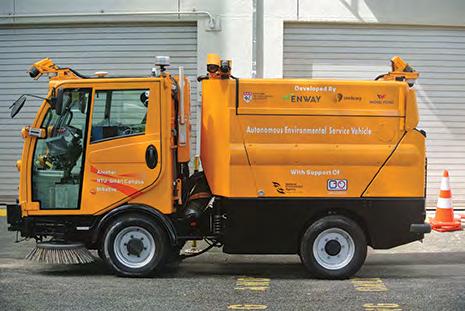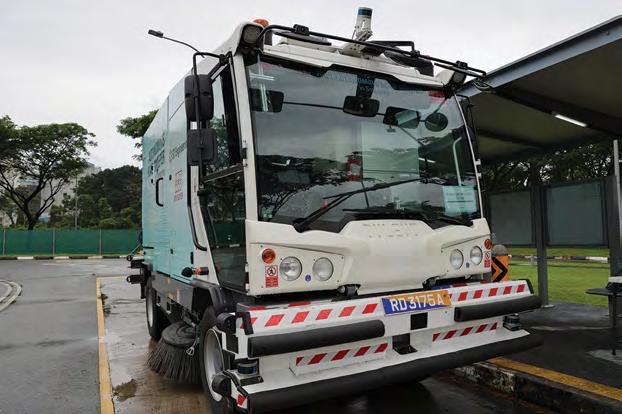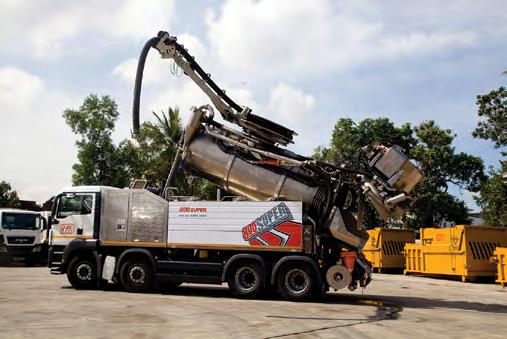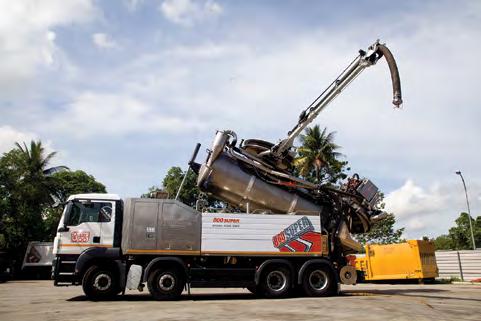
11 minute read
Trials of autonomous road cleaning vehicles commence Future deployment of the technology will pave the way for an innovative and transformed environmental services industry
TRIALS OF AUTONOMOUS ROAD CLEANING VEHICLES COMMENCE
Future deployment of the technology will pave the way for an innovative and transformed environmental services industry.
The National Environment Agency (NEA) has launched proof-of-concept (POC) trials of two Autonomous Environmental Service Vehicles (AESVs) for road cleaning. The trials, which will run until July 2021, will be conducted in designated small-scale testbed environments at onenorth, Nanyang Technological University, and CleanTech Park at Jurong Innovation District. The projects are part of NEA’s Environmental Robotics Programme and are in line with NEA’s continual efforts to better optimise resources, drive innovation, push technology adoption, and improve productivity across the Environmental Services (ES) industry. The Environmental Robotics Programme was launched by NEA in December 2017 as part of the National Robotics R&D Programme. It focuses on the development of robotics solutions to achieve the following: • Enable productivity gains. • Enable a sustainable manpower stream. • Enhance current capabilities and enable new ones. The POC trials follow the award of Research & Development (R&D) projects for the design, development and trial of AESVs for road cleaning by NEA and Ministry of Transport (MOT), in March 2019, to two consortia: • Nanyang Technological University / Enway Pte Ltd /
SembWaste Pte Ltd / Wong Fong Engineering Works (1988) Pte Ltd. • ST Engineering / 800 Super Waste Management Pte Ltd. The AESVs have been modified from existing mechanical sweepers with multiple sensors on all sides of the vehicles and computing units in the cabin. They have been developed with support from the National Robotics Programme (NRP) and various public agencies. The NRP is a national level programme that nurtures the robotics ecosystem in Singapore through funding research and development, to enhance the readiness of robotics technologies and solutions. Key considerations for NRP’s R&D investments include potential for impactful applications in the public sector and potential to create differentiated capabilities for the industry. The POC trials of the AESVs will be conducted in a progressive manner, starting with off-peak timings (i.e. weekends and evenings). Both AESV units have undergone rigorous safety assessments by the Land Transport Authority and have been approved for public road trials in small-scale testbed environments. In line with the safety framework for autonomous vehicle (AV) trials, the AESVs are required to have a safety driver on board at all times, who is trained to take immediate control of the vehicle when needed, in accordance with strict operational protocols. The operation of each AESV will be monitored in real-time from a command centre, by an off-site operator cum cleaning professional, who can deploy the AESVs on different cleaning routes based on cleaning needs. For easy identification by other road users and in line with the AV safety framework, all AESV test vehicles will display prominent decals and markings. The application of AV technology to mechanical road sweepers will enable service providers to adopt more innovative technologies to raise the standards, productivity and professionalism of the ES industry. It will help foster an innovative ES industry equipped with a skilled and future-ready workforce, and create a more sustainable manpower stream by making these jobs more attractive to locals. The successful completion of the POC trials will pave the way for the pilot deployment of AESVs for road cleaning in the early 2020s. Mr Patrick Pang, Chief Technology Officer of NEA, said, “The commencement of the Autonomous Environmental Service Vehicles road trials marks a key milestone in its R&D journey, which aims to augment manpower in the Environmental Services industry, particularly the cleaning sector. Such R&D work had started in 2019, bringing together academics and companies from various industries such as robotics, transportation, and environmental services, to jointly develop these vehicles. Successful trials will pave the way for downstream commercialisation and operationalisation. We look forward to greater innovations by the industry and together, we can push the frontiers of environmental technologies and solutions, and build a vibrant and sustainable Environmental Services industry”. Mr Daryl Yeo, Director (Futures & Transformation) of MOT, said, “The pilot deployment of AESVs will help shift cleaning activities to off-peak hours such as late night hours and reduce road congestion. This demonstrates the strong potential of autonomous systems to make our transport network more efficient and future-ready”.
Ranked amongst the world’s top universities by QS, NTU Singapore has been named the world’s top young university for the past seven years. Under the NTU Smart Campus vision, the university harnesses the power of digital technology and tech-enabled solutions to support better learning and living experiences, the discovery of new knowledge, and the sustainability of resources. Principal Investigator Professor Wang Danwei from the School of Electrical and Electronic Engineering leads this AESV project which includes the development of novel technologies for off-site operations and robot cyber security solutions. Prof Wang is an expert on multi-modal sensing, perception, and autonomy of unmanned systems in unstructured environments. Enway is a developer of autonomous software for heavy duty vehicles, focusing initially on the cleaning industry, with its Blitz class autonomous industrial sweeper launched in September 2019. Enway combines knowhow in engineering, robotics, machine learning, computer vision and artificial intelligence with operational expertise that is unique in the professional cleaning industry. As Co-Principal Investigator, Enway is developing the AESV’s navigation system and autonomous road sweeping functionality. SembWaste is the waste management and recycling arm of Sembcorp Industries, a focused energy and urban development company offering sustainable solutions. A leading environmental services company, SembWaste provides waste management, public cleaning and recycling services, and is the operational partner for the public trials of the AESVs. Wong Fong is a trusted provider of land transportation engineering solutions and systems. For this project, the company developed and manufactured the AESV’s field infrastructure including the docking station and waste compactor for autonomous dumping.
Product features
The AESV makes street sweeping sustainable and efficient in the following ways: • Zero carbon emission, less noise: The AESV is fully electric and has lower ambient noise output compared to conventional sweepers. • Improves productivity: - Operations can be shifted to late nights/early mornings, avoiding rush hours and optimising road usage. - The system allows for dynamic route planning and remote operation to ensure the AESV can handle all situations it encounters. • Precise cleaning: The ability to autonomously sweep along the kerb facilitates effective cleaning of heavy debris areas. • Safety: The AESV is cybersecure, to guard against malicious attacks on its sensors and actuation systems. • Tested on the NTU Smart Campus: A living testbed for innovative digital and tech-enabled solutions, the NTU
Smart Campus is home to the Centre of Excellence for Testing & Research of Autonomous Vehicles - NTU (CETRAN), where public road trials for the AESV will be conducted in small-scale testbed environments.
Product specifications
• 8 hours sweeping range and 2.5 hours charge time. • Equipped with 3D LiDAR sensors and cameras for localisation, kerb following and traffic navigation. • Sweeping speed of up to 12 km/hr. • Vacuum-based debris collection system. • Autonomous docking and hopper emptying. • Remote monitoring and route planning. • Cyber security functions.
ST Engineering is a global technology, defence and engineering group with offices across Asia, Europe, the Middle East and the US, serving customers in more than 100 countries. The group uses technology and innovation to solve real-world problems and improve lives through its diverse portfolio of businesses across the aerospace, smart city, defence and public security segments. ST Engineering has an established track record in autonomous systems development and deployment across diverse industry applications in Singapore and overseas. The AESV system is developed by its Logistics Automation business which specialises in developing robotics and autonomous systems that enhance the efficiency and reliability of the transport, logistics, manufacturing, healthcare and hospitality industries. 800 Super is an established home-grown environmental services provider for the public and private sectors in Singapore. With a broad range of environmental solutions ranging from waste management and treatment, and cleaning and conservancy services, to horticulture and landscaping services, 800 Super has been a front-runner in the environmental services industry, since 1986. In 2019, the company further elevated its capabilities, to include cogeneration of renewable energy, and is the first and only carbon-neutral industrial laundry and steam heating facility in Singapore. 800 Super has since commissioned and operates a self-sustaining integrated energy and resource recovery facility that houses a biomass plant, sludge treatment plant, industrial laundry plant, animal feed processing and a third-party ISO tank container steam heating facility. Designed and developed by ST Engineering in collaboration with 800 Super, the AESV performs pre-defined road cleaning operations, moving from one designated location to another. It uses a commercial Dulevo 6000 Series sweeper vehicle platform integrated with a Drive-By-Wire system and autonomous navigation capabilities based on LiDAR technology.
Product features
• Environment-friendliness: - The ability to completely eliminate fine particles compared to normal sweepers while saving up to 60% of water usage. - A unique mechanical filtering and suction system guarantees the total elimination of PM10 fine particles. • Precise navigation and cleaning: Effective kerb detection capabilities allow the AESV to autonomously sweep along the kerb, allowing for highly effective cleaning. • Safety: The platform is fitted with a suite of sensors, that provides all-round obstacle detection, thereby allowing the AESV to sense its environment to navigate safely during sweeping operations and when on the move. The AESV’s speed is automatically adjusted, to maintain a safe distance between itself and external objects. Should an object enter its collision zone, the emergency brake will be activated to bring the AESV to a safe stop. • Completed scenario-based public road trials in onenorth under light traffic conditions. A series of scenario-based tests were also conducted in a controlled circuit environment at CETRAN before progressing to public road trials.
Product specifications
• Operating speeds: - Manual mode: 40 km/h - Autonomous mode: up to 15 km/h - With sweeping mode: 10 km/h • Equipped with a Global Positioning System (GPS), 3D
LiDAR sensors and front and rear cameras, for localisation, kerb following and traffic navigation. • Localisation accuracy up to 5 cm. • Stopping distance within 6 m based on the prevailing speed.

• Three emergency stop buttons, located at the rear left and right of the AESV, and next to the driver’s seat in the cabin. • Autonomous cleaning function facilitated by left, right and centre brushes with water jets. • 6000-litre waste container capacity and the ability to operate in all locations including public roads. • Unique mechanical suction filter system that enables the absorption of fine particulate matter of PM10/
PM5/PM2.5/PM1 size.
TRANSFORMING CLEANING OPERATIONS THROUGH INNOVATION AND TECHNOLOGY
NEA has been working with industry partners to transform the ES industry through various initiatives. This includes implementing the use of innovative technological tools that alleviate the manual workload of cleaners and increase their productivity. NEA also adopts outcome-based contracts. This places greater emphasis on the use of technology and automation when selecting service providers for awarding of cleaning contracts. Outcome-based contracting, where a service buyer prescribes performance outcomes instead of headcount requirements, is an important contract mechanism to ensure that there is continuous strong interest among service providers to innovate and adopt new technologies. Thus far, NEA’s cleaning service providers have implemented the application of pavement sweepers for cleaning parks and pavements, mechanical sweepers for the cleaning of roads, and specialised truck-mounted machines that desilt and flush underground drain pipes. NEA will continue to work with key stakeholders, including service buyers, to push for wider adoption of outcome-based contracting to improve productivity in the cleaning sector. This, in turn will spur service providers to invest and propose the use of technology and innovative solutions, as well as enhance processes that can improve productivity to meet the desired cleaning outcomes.
Successful implementation of cleaning equipment
The current range of cleaning equipment that NEA uses is operated by trained machine operators who have undergone training in the operation and safe handling of the machines. The cleaners’ jobs have been redesigned in the process and made easier, safer and smarter, as they take on higher value-added tasks such as operating mechanised equipment. Cleaners also undergo upskilling to strengthen competencies to take on the redesigned job roles effectively. All mechanical sweeper vehicles are equipped with a Cleanliness Performance Monitoring System (comprising GPS tracking system, cameras and sensors), which enables NEA officers to track the routes taken by the vehicles, and to monitor their cleaning performance by tracking the various cleaning functions of the vehicle. With these devices installed, officers would be able to determine whether the vehicle is travelling at the right speed for optimal sweeping, or whether the broom and water sprayers are switched on during cleaning hours, or whether the vehicle is at the right place. If any of the cleaning thresholds have been breached, the system will generate alerts so that officers can immediately request for the necessary rectifications from the cleaning service providers. The system also transmits video images in real-time, which will help to monitor the cleaning performance of these vehicles.

Normal road sweeper.


Specialised trucks are used to desilt and flush underground drain pipes.
The images were taken before the outbreak of COVID-19.








